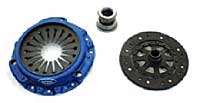On the other hand, if the car didn’t have a clutch, there would be no way of disconnecting the running engine from the transmission so that you could change gears or, for that matter, stop the car while keeping the engine going. For a quick primer in how a clutch operates, check out www.howstuffworks.com/clutch.htm.
Yet, it’s the contact between the two plates, the springs that hold the plates together, the friction material on the clutch plate, and the release mechanism that pulls the plates apart that can make all the difference. These parts determine how quickly and smoothly the plates separate to allow a quick gear change, and how quickly and tightly the plates go back together to put the power back to the wheels. And that speed and efficiency makes a big difference in performance and driving sensations when the car is pushed close to its limits on the track, in and out of the cones on an autocross course or on the curves of a scenic backroad.
Like many other performance parts, clutches represent trade-offs between price and performance, and between speed and comfort. The clutch with which the car is equipped from the factory is a good component, but is built to a budget. More important, it is built with the average (or below-average) driver in mind, so its design and choice of materials err in favor of comfort and longevity, rather than performance and speed.
If you’re thinking about using your MINI Cooper or Cooper S in a more enthusiastic way than that average driver, you may be willing to pay spend some money to improve the performance of your clutch. Of course, you should also be willing to accept the need to be more quick and precise with your gear changes than that average driver so that you don’t start off, or go through gear changes, in neck-snapping fits and starts.
If you are, a performance clutch kit may be your ticket. But it isn’t a simple, “either-or” choice, since there are several levels of upgrade available. One typical catalog, for example, offers a “high-perfor
 mance street kit,” a “casual autocross kit,” a “casual drag race kit,” a “race kit” and a top-of-the-line “high performance flywheel/clutch system.”
mance street kit,” a “casual autocross kit,” a “casual drag race kit,” a “race kit” and a top-of-the-line “high performance flywheel/clutch system.”Choosing the one that’s right for you is largely determined by what you want to do with your car. Aside from the top-of-the-line system, the prices aren’t significantly different for various applications. These kits sell in the range of $400 to $600, not including installation.
All of the kits consist of the clutch disc that is pressed against the flywheel when the clutch is engaged, the pressure plate that pushes the clutch against the flywheel, the throwout bearing which pushes the clutch disc away from the flywheel when the clutch pedal is depressed, and the alignment tool needed to install the parts.
It is the type of friction material that makes the difference among the clutches designed for different applications. In the “street kit” level, a steel-backed woven organic material is used, that allows a small amount of slippage before hooking up. This slippage, though less than that of the stock clutch disc, will smooth out the clutch engagement when starting off from a stop. Allowing the clutch to slip slightly can be important in situations such as starting from a stop on a hill.
The higher performance clutches will engage more positively, since the intention is to get off from a stop as quickly as possible, and spend as little time as possible with the flywheel spinning but not connected to the transmission while shifting gears. On these clutches, kevlar, carbon or ceramic materials are used on the clutch disc, which allow for less slippage than stock disc materials as the clutch is engaged.
At the level of performance and activities being discussed in this chapter, where you’re using the car as a daily driver, but taking it out occasionally for a track day, autocross, or long-distance tour, you will probably be quite happy with a high-performance street kit. The organic disc material will provide more grip and quicker engagement and disengagement than the stock clutch, but still allows a little slippage.








1 comment:
Finally!
A blog worth reading on forward until the end! :) I really admire the wording in this blog, quite precise to the details but I just might change one or two things, never-the-less, bravo on well choiced words mate.. p.s.>> Thanks for sharing, I actually picked up some knowledge on this one :)
-Have an amazing day!
Post a Comment